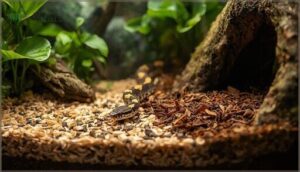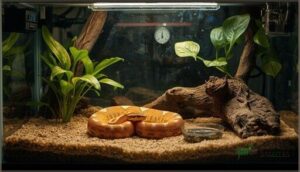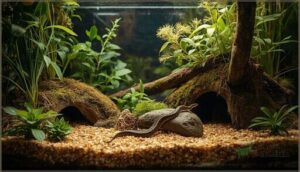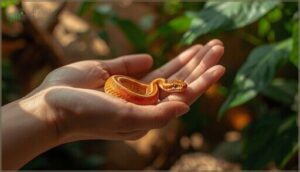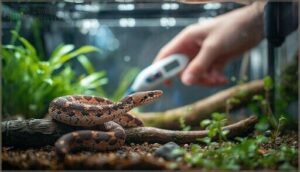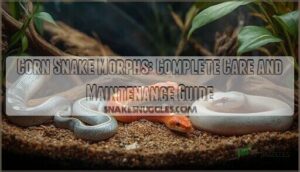This site is supported by our readers. We may earn a commission, at no cost to you, if you purchase through links.
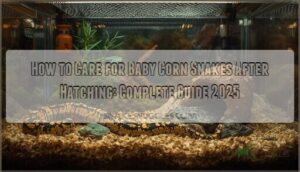
A baby corn snake can slip through a gap no wider than a pencil, and that knack for escape is only the beginning. Caring for baby corn snakes after hatching calls for more than a cozy tank—it’s a blend of vigilance and science.
The difference between a thriving hatchling and a stressed one often comes down to details: precise temperatures, secure lids, and prey measured to the gram. If you want your young snake to grow strong and shed cleanly, every step matters.
From setting up the enclosure to handling with confidence, the right approach shapes their health from day one.
Table Of Contents
- Key Takeaways
- Preparing The Enclosure for Hatchlings
- Creating The Ideal Temperature and Humidity
- Furnishing and Decorating The Habitat
- Feeding Baby Corn Snakes
- Handling and Socializing Hatchlings
- Monitoring Health and Preventing Illness
- Supporting Growth and Shedding
- Frequently Asked Questions (FAQs)
- Conclusion
Key Takeaways
- Secure your snake’s enclosure with a tight-fitting lid and check for gaps smaller than a pencil to prevent escapes.
- Maintain a temperature gradient of 75–85°F and humidity around 65–75% using thermostats, hygrometers, and a moist hide for healthy growth and shedding.
- Feed hatchlings appropriately sized frozen-thawed pinkie mice every 5–7 days, adjusting prey size and feeding intervals as your snake grows.
- Handle your baby corn snake gently for short sessions, watch for stress signals, and clean the enclosure regularly to prevent illness.
Preparing The Enclosure for Hatchlings
Creating a safe and comfortable home is the first step for your baby corn snake. The right setup makes a big difference in how well your snake settles in. Here’s what you’ll need to get started.
Choosing The Right Tank Size
Tank size impacts everything for your baby cornsnake—from stress to health. Choose a 10-gallon tank for hatchlings. It allows proper temperature gradient and humidity, space enrichment, and hides without feeling overcrowded. Corn snakes are popular because of their docile nature. Watch for these three keys:
- Outgrowing it? Upgrade timing matters.
- Use secure enclosure types only.
- Avoid tanks that cramp or overwhelm.
Essential Security and Escape Prevention
Once your corn snake’s tank fits just right, lid security becomes your main defense. Hatchlings are experts at slipping through tiny gaps—2 mm is all it takes. Use locking mechanisms made for reptile tanks and check mesh or lids often. Preventive maintenance lowers escape incidents.
A secure tank keeps the snake in and lets you control temperature, humidity, and handling routines. Proper enclosure setup includes using a digital thermometer to monitor the environment.
Setting Up Hides and Shelter
After you lock down your habitat’s lid, focus on hiding places—snakes spend over 90% of daylight in shelters. Size matters: each hide must fit the whole snake but stay snug. Opaque plastic or disinfected wood keeps it dark. Place one at each end, plus a humid hide in the middle.
For enrichment, add ground and elevated shelters to your terrarium setup.
Recommended Substrate Options
Once your hides are set, turn to substrate choices. A Substrate Depth of 3–4 inches lets hatchlings burrow comfortably and aids humidity control. Aspen shavings or ReptiChip stand out for clean, basic setups, but DIY Substrates—topsoil blends help with humidity in a bioactive Reptile Habitat and Environment.
Stay sharp—skip pine, gravel, or anything increasing impaction risks or hygiene headaches.
Creating The Ideal Temperature and Humidity
Getting the temperature and humidity right is key for your baby corn snake’s health and comfort. Small changes in their environment can make a big difference.
Here’s what you’ll need to set up an enclosure that keeps your hatchling safe and thriving.
Establishing a Thermal Gradient
Ever tried baking bread without the right temperature zones? It’s the same for your snake—a baby corn relies on a well-set thermal gradient. For reliable reptile habitat setup, make sure your heating pad and temperature gradient reflect true Basking Zone and Cool Zone Standards.
- Place the heating pad covering one-third of the enclosure (Gradient Zone Placement).
- Use two hides for behavioral choice.
- Check temperature often—incorrect gradient risks health.
Heating Methods and Monitoring
For your baby corn snake, balancing temperature zones takes more than just a heating pad. Thermostat-controlled heating devices are essential for safety and create a stable temperature gradient. Modern monitoring technology, like digital thermometers, makes zoning and heating effectiveness easy to track. Use the table below for a quick guide on device use and monitoring.
| Heating Device | Placement | Monitoring Method |
|---|---|---|
| Heat mat/pad | Under tank, 1/3 base | Digital probe/thermostat |
| Ceramic emitter | Above warm zone | Infrared thermometer |
| Halogen bulb | Above basking spot | Digital thermometer |
Maintaining Proper Humidity Levels
For trustworthy reptile care, pay close attention to humidity monitoring. Aim for 65–75% humidity in your terrarium setup.
Low humidity leads to shedding issues and dehydration; high humidity risks fungal infection. Use two hygrometers to keep your snake’s environment stable.
Regularly mist, ventilate, and position water bowls carefully to keep humidity and temperature in the healthy range.
Setting Up a Humid Hide
Did you know a well-placed humid hide can mean the difference between a healthy shed and stubborn skin? For baby corn snakes, focus on:
- Hide placement: Place on the cool side or midpoint of your terrarium setup.
- Material selection: Use opaque plastic and moist moss for comfort.
- Maintenance protocols: Check humidity levels and substrate weekly.
This careful reptile care promotes stress-free shedding benefits.
Furnishing and Decorating The Habitat
A comfortable and enriching habitat helps your baby corn snake feel at home. You can make their space both safe and interesting with a few simple touches.
Here’s what to focus on as you set up their enclosure.
Safe Climbing Branches and Enrichment
Think of each safe branch as a mini climbing gym for your hatchling—sanitized maple or cork oak offers both security and stimulation. Proper branch sanitation keeps your habitat safe.
Place each climbing structure securely, no higher than 20 cm, to match handling needs and maintain correct temperature.
Branches aren’t just décor—they shape snake behavior, boost enrichment benefits, and support healthy exploration.
Selecting Water Dishes and Placement
A sturdy water dish does more than just hydrate—it anchors your reptile habitat setup. Choose ceramic or heavy plastic to prevent spills and reduce drowning risk.
Bowl size matters; for hatchlings, stick to 2–3 inches wide. Place the dish where your snake can reach it easily, as placement impacts humidity and facilitates safe, frequent cleaning protocols.
Using Plants and Natural Decor
Once the water dish is set, turn your attention to decorative plants. Safe plants or lifelike artificial options aren’t just for show—they support Bioactive Benefits and Enrichment Impacts.
Live greenery helps stabilize your tank’s microclimate, making your habitat more stimulating. Mixing branches, cork, and leafy decor creates a terrarium setup that encourages natural hiding, climbing, and exploration.
Regular Cleaning Practices
A well-decorated tank looks inviting, but daily spot cleaning keeps your baby corn snake’s habitat safe. Remove waste and replace damp aspen shavings weekly.
Schedule deep cleaning every month using a reptile-safe disinfectant on hides, water dish, and decor. Consistent substrate changes and hygiene monitoring prevent illness, making Snake Housing secure and stable for proper temperature and health.
Feeding Baby Corn Snakes
Feeding your baby corn snake the right way sets the stage for healthy growth. There are a few key pieces to focus on, from picking the right prey size to getting the timing right.
Let’s look at what you’ll need to know to start things off strong.
Choosing Appropriate Prey Size
From the start, getting prey size right protects your baby corn snake’s health. Choose pinkie mice 1–1.5 times the snake’s mid-body width and keep prey weight near 10% of the newborn’s own weight. Sticking to frozen-thawed prey, not live, greatly reduces regurgitation risks. Watch for:
- Visible bulge after feeding
- Prey types: pinkie mice
- Weight percentage matters
- Gradual size changes
Feeding Frequency and Schedule
Matching prey size sets the foundation, but timing matters just as much for a baby corn snake. Hatchling feeding falls every 5–7 days, supporting steady growth. Juvenile intervals widen to every 7–10 days. Adult schedules stretch further, minimizing overfeeding risks. Stick to this rhythm, and if regurgitation occurs, extend the gap to help your snake recover.
| Stage | Interval (Days) | Prey Type |
|---|---|---|
| Hatchling | 5–7 | Pinkie Mice |
| Juvenile | 7–10 | Larger Mice |
| Adult | 14–21 | Adult Mice |
| Regurg. Recovery | 7–10 | Smaller Prey |
Preparing Frozen-Thawed Prey
For successful snake feeding, thawing methods make all the difference. Move frozen-thawed prey from the freezer to the fridge overnight, or use warm (never hot) water for 10–15 minutes. Temperature control is key—aim for 98–100°F to mimic live prey. Never microwave prey.
Safety risks drop and snake nutrition stays high, supporting overall corn snake care and feeding success.
Avoiding Live Feeding Risks
Although live feeding might seem natural, baby corn snakes suffer higher Prey Injury Rates, Stress Response, and Disease Transmission when offered live food versus Frozen-Thawed Prey.
For your hatchling’s Feeding Safety and Long-Term Health, stick to frozen-thawed options. This fosters better Snake Feeding and Nutrition, Reptile Health and Hygiene, and easier Snake Care and Maintenance for new keepers.
Handling and Socializing Hatchlings
Getting your baby corn snake used to gentle handling early on makes a world of difference. With patience and the right approach, you can help your hatchling feel safe and comfortable in your hands.
Here’s what you need to know before you get started.
Safe Handling Techniques
Handling your baby corn snake is all about safety and confidence, both for you and the animal. Picture each interaction as building trust, not just tackling a task.
Practice these essentials:
- Wash hands before and after for excellent hand hygiene
- Sanitize handling tools
- Support the snake’s body, never by the tail
- Follow a consistent handling schedule
- Limit novice safety risks with gentle, steady movements
Minimizing Stress During Handling
A calm baby corn snake is like a breeze through grass—barely a ripple when you do things right. Gentle handling starts with a gradual introduction, letting your snake explore your hands in the enclosure first.
A calm baby corn snake responds best to gentle handling, starting with slow, gradual introductions inside its enclosure
Keep the lights low, noises down, and watch for stress signals. With these environmental modifications and focused stress recognition, you’ll see faster, smoother post-handling recovery.
Frequency and Duration of Handling Sessions
Think of handling your baby corn snake as setting a gentle routine—they benefit from short handling sessions of 5 to 10 minutes, spaced 2–4 times a week. Younger snakes need less contact, while older hatchlings adapt to more frequent, longer sessions.
Respecting these handling frequency and session duration guidelines aids stress reduction and healthy snake handling and behavior.
Recognizing Signs of Stress
Ever notice your baby corn snake darting away or “glass surfing” after handling? These escape attempts signal stress. Defensive posturing, like S-shaped coiling or tail rattling, means it feels threatened.
Watch for feeding changes, incomplete sheds, or rapid breathing—these physiological indicators reveal deeper reptile health concerns. Understanding animal behavior helps you respond quickly and protect your snake’s well-being.
Monitoring Health and Preventing Illness
Keeping your baby corn snake healthy starts with knowing what to watch for and how to respond. There are a few key things you’ll want to keep an eye on as your hatchling grows.
Here’s what to look out for in their enclosure and daily care.
Common Health Issues in Hatchlings
In the early days after hatching, your baby corn snake can face several threats to reptile health. Issues like shedding problems, parasitic infections, feeding refusal, congenital issues, and respiratory illness are all common in newborn snakes. Prompt action sets the foundation for strong veterinary medicine and health.
- Shedding Problems
- Parasitic Infections
- Feeding Refusal
- Congenital Issues
- Respiratory Illness
Identifying Signs of Illness or Distress
Spotting illness in hatchlings means watching for lethargy signs or unusual hiding, feeding refusal, and breathing issues like wheezing or mucus. Skin abnormalities, such as patches from poor sheds, can flag deeper problems. Stress behaviors—tail rattling or frantic escape—show your snake’s discomfort.
Careful health checks will keep you ahead, supporting reptile health and wellness with well-informed attention to snake behavior.
Importance of Cleanliness and Hygiene
Cleanliness in your reptile habitat setup isn’t just about a tidy tank—it’s key for pathogen control and protecting against zoonotic disease. Hand washing after handling, regular substrate changes, and routine disinfectant use all promote newborn snake health and wellness. For instance, keeping water bowls clean helps prevent bacteria buildup and encourages proper hydration.
- Spot-clean daily for waste
- Disinfect surfaces weekly
- Replace substrate every few months
When to Seek Veterinary Care
If your baby corn snake shows emergency symptoms—like labored breathing, stuck shed, or sudden lethargy—don’t wait. For newborn snake care tips, acting fast means better outcomes and aids Reptile Conservation and Welfare.
Veterinary medicine aids Animal Health and Wellness, especially with prompt care. Preventative screening and parasite management cut risks. Surgical safety is high, but follow-up compliance matters.
Supporting Growth and Shedding
Helping your baby corn snake grow and shed well starts with the right setup. There are a few key things you’ll want to include in their enclosure.
Here’s what to focus on as your hatchling matures.
Providing Moist Hides for Shedding
Did you know a moist hide can make shedding as smooth as silk for your Baby Corn Snake? Use sphagnum moss or coconut fiber for ideal hide materials.
Keep humidity levels inside the hide at 65–75%. Place the hide near the warm side.
This setup boosts hydration, prevents mold, and leads to complete shedding outcomes—reducing stuck shed and health risks.
Signs of Healthy Growth
Growth in your Baby Corn Snake is like watching a well-tuned engine run—everything works in harmony. Consistent Weight Gain, Regular Shedding every 4–6 weeks, and Clear Eye Clarity show solid Corn Snake Care and Maintenance.
You’ll see Active Behavior, Strong Appetite for Feeding, and smooth Reptile Nutrition. These signs confirm your Snake Care routine is on track.
Addressing Shedding Difficulties
Shedding troubles often reveal gaps in Humidity Management or Hydration. If you spot flaky patches or retained skin, Identifying Dysecdysis early is key. Try Assisted Shedding with a humid hide or gentle soaking.
Preventative Measures like regular misting help, but persistent issues may require Veterinary Intervention. Careful Snake Care means watching humidity and providing rough surfaces for your Baby Corn Snake’s comfort.
Adjusting Care as Hatchlings Mature
Ever notice how your Baby Corn Snake outgrows its old hide as quickly as a child’s shoes? You need to keep pace with these changes.
- Upgrading enclosure size for safe movement
- Shifting feeding schedule with growth benchmarks
- Watching for behavioral changes as maturity sets in
- Expanding handling practices to match rising confidence
This keeps Snake Feeding and Handling stress-free.
Frequently Asked Questions (FAQs)
How to transport baby corn snakes safely?
When transporting baby corn snakes, use ventilated containers with secure lids to prevent escape. Regulate temperature with heat packs, assess each snake’s health before travel, and handle gently. This reduces stress and ensures your pet snake’s safety.
Can baby corn snakes be housed together?
Letting baby corn snakes share a tank is playing with fire. Cannibalism risks, stress indicators, disease transmission, and feeding challenges all rise sharply.
Professional reptile husbandry and animal behavior experts recommend solitary housing for best welfare outcomes in Reptile Care.
How to identify the snake’s gender?
To identify a corn snake’s gender, genetic testing from shed skin is the most reliable method.
Probing accuracy is high but requires expertise, while popping carries risks.
Visual methods using tail morphology are often unreliable in Elaphe guttata hatchlings.
What is the best way to tame hatchlings?
Start with an initial acclimation period, then use safe techniques like gentle, brief handling.
Minimize stress by keeping sessions quiet and short—about 5 minutes.
Handling frequency should be 1–2 times weekly for successful long-term socialization.
Are corn snakes sensitive to household noises?
Corn snakes show Vibration Sensitivity and react to Noise Stressors like loud voices or footsteps. Soundproofing Enclosures helps reduce stress.
Individual Variation means some hatchlings tolerate Calming Sounds, but others may hide or refuse food. Animal Behavior matters in Pet Care.
Conclusion
Nearly 80% of hatchling corn snake escapes happen in the first two weeks, highlighting how small details can shape their safety.
Caring for baby corn snakes after hatching means treating every step as essential—from securing the lid to measuring prey.
When you focus on their environment, nutrition, and gentle handling, you give your hatchling the best chance to thrive. Each choice you make is a building block, laying the foundation for a healthy, confident adult snake.
- https://www.wikihow.com/Care-for-Baby-Cornsnakes
- https://reptifiles.com/corn-snake-care-guide/corn-snake-temperatures-humidity/
- https://community.morphmarket.com/t/corn-snake-care-guide/39834
- https://www.petmd.com/reptile/corn-snake-care-sheet
- https://www.reddit.com/r/cornsnakes/comments/i1et7d/feeding_advice_for_baby_corn_snake/




